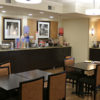Ordinances and regulations which have been enacted over the years by local, state, and federal governments around the world have thankfully required that the new construction of lodging facilities be equipped with sprinklers in case of a fire, as the sprinkler head senses the heat and automatically activates quickly when the temperature is too hot.
Stupid Tip of the Day: Why You Should Not Place Hangers On Fire Sprinkler Heads in Hotel Rooms
Installed behind the walls and ceilings of a building which is equipped with a fire sprinkler system is a network of pipes that are filled with water which is under pressure at all times. Individual sprinklers are strategically placed along the pipes to protect the areas beneath them — whether the area is a hotel room or a lobby. If a fire erupts, the temperature of the air above the fire rises; and when the air reaches a certain temperature — typically between 135 degrees Fahrenheit and 165 degrees Fahrenheit — the sprinkler is immediately activated and forcefully sprays water over the flames until the fire is completely extinguished in most cases. In some cases, fire sprinkler systems control the heat and limit the development of toxic smoke until the fire department arrives, as smoke will not activate fire sprinkler heads…
…but heat is not the only element which can activate a fire sprinkler head. For whatever reason, some guests in hotel rooms tend to use fire sprinkler heads to hang their clothes or other objects — even if the room is equipped with a closet with hangers. Perhaps the closet did not have enough clothes hangers in them?
Clothes hangers typically do not activate the head of a fire sprinkler — but the occurrence has been known to happen; and once it happens, the damage is basically done: as the water has been in the pipes for months or even years, the first several dozen gallons of water which is released could be an off color — perhaps yellow, brown, or even black — and also have an unpleasant odor as well due to mold or other substances…
…but that is not even the worst of the problems: hundreds of gallons of water could have been forcefully expelled by the time the water is shut off, which can potentially cause tens of thousands in damage for which the guest will likely be liable to pay.
Other Facts About Fire Sprinkler Heads
Movies tend to propagate the myth that once one head of a fire sprinkler system is activated, then all of them are activated. Typically, only the sprinkler head nearest the fire activates — although some systems might have a few sprinklers “attached” to each other; so when one fire sprinkler head is activated, the other few fire sprinkler heads are also activated.
If you look carefully at a fire sprinkler head in your hotel room, you might notice a small glass tube with a red liquid in it. This indicates the threshold of heat which is required to break the glass which encases the liquid, which is somewhat similar to the color coding system that is increasingly used on fire hydrants in cities:
- 135° Fahrenheit or 57° Celsius = Orange
- 155° Fahrenheit or 68° Celsius = Red
- 174° Fahrenheit or 79° Celsius = Yellow
- 200° Fahrenheit or 93° Celsius = Green
- 286° Fahrenheit or 141° Celsius = Blue
- 360° Fahrenheit or 182° Celsius = Mauve
- 440° or 500° Fahrenheit or 227° or 260° Celsius = Black
Final Boarding Call
Do not hang hangers — or anything else, for that matter — on sprinkler heads, as they can potentially cause substantial damage which can be easily prevented…
…and if your hotel room does not have enough hangers on which to hang clothes, simply call the front desk or the housekeeping staff and ask for more — or use the back of a chair, if necessary. Bathrooms in hotel rooms are also usually equipped with at least one hook on the back of the door or on a wall; and you can also use the shower curtain rod to hang clothes, if necessary.
To remind guests not to hang anything from the heads of a fire sprinkler system, small placards or stickers are sometimes placed next to each sprinkler head, as I encountered in a hotel room greater than nine years ago…
Photograph ©2021 by Brian Cohen.

